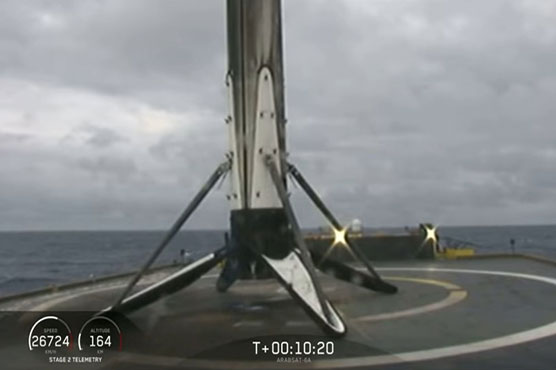Falcon Heavy center core toppled after landing

SpaceX recovered a payload fairing for the first time in 2017.
(Web Desk) - SpaceX says it lost the Falcon Heavy’s center core after ‘rough sea conditions’ caused it to topple over as it was being transported back to the Florida coast.
Elon Musk‘s rocket company managed to make history on Thursday when it landed three boosters back on Earth for the first time, following the Falcon Heavy megarocket’s successful second launch into space.
But as ocean swells continued to rise, wave heights caused the center core to fall off of the company’s drone ship, dubbed ‘Of Course I Still Love You,’ which is stationed in the Atlantic Ocean, according to the Verge.
‘Over the weekend, due to rough sea conditions, SpaceX’s recovery team was unable to secure the center booster for its return trip to Port Canaveral,’ SpaceX said in a statement.
‘As conditions worsened with eight to ten foot swells, the booster began to shift and ultimately was unable to remain upright.
‘While we had hoped to bring the booster back intact, the safety of our team always takes precedence. We do not expect future missions to be impacted,’ the firm added.
The core wasn’t tethered to the drone ship, causing it to be lost at sea.
SpaceX does have a mechanism, called the ‘octograbber,’ which is located on Of Course I Still Love You that can aid in the process of recovering rocket parts.
The robot, designed to secure rocket boosters after they land, isn’t capable of latching onto Falcon Heavy cores, so it wasn’t used in this latest mission.
SpaceX’s next Falcon Heavy mission, slated for this summer, will use a new center core, so the loss of the core from last week’s mission won’t affect it.
Additionally, the firm expects to put the octograbber to work during the upcoming mission, the Verge reported.
Even with the loss of the center core, it doesn’t overshadow the milestone of SpaceX landing all three of the Falcon Heavy’s boosters.
In addition to the center core’s landing, the two side boosters landed back on pads at Cape Canaveral Air Force Station’s Landing Zone 1 and 2.
‘We have landed the center core for the first time,’ a SpaceX announcer said. ‘Three for three boosters today for the Falcon Heavy.’
SpaceX was also able to recover both fairing halves of the megarocket for the first time.
Before Thursday’s launch, it had been fourteen months since Falcon Heavy’s maiden launch, when it blasted off to become the most powerful rocket in use today.
SpaceX tries to re-use rockets, payload fairings, boosters and other parts to try to cut down on the cost of each rocket mission.
The total cost of one of its Falcon 9 launches is estimated to reach £44 million ($61m), while each of its larger Falcon Heavy flights costs £65 million ($90m).
The space company has previously re-used first-stage and second-stage rocket boosters, in addition to one of its previously flown Dragon capsules.
The Dragon spacecraft are used as the final stage of SpaceX missions to resupply the International Space Station.
SpaceX is currently testing a system to recover the fairings of its Falcon 9 rockets.
The payload fairings are clam shell-like nose cone halves that protect the craft’s payload.
SpaceX recovered a payload fairing for the first time in 2017.
During its first Falcon Heavy launch in February 2018, the firm landed two of the firms side boosters simultaneously on separate launchpads.

